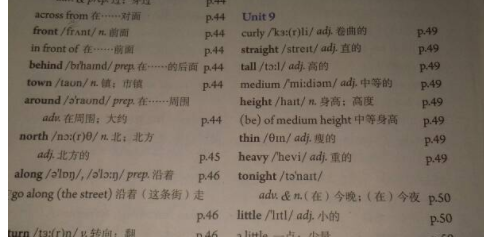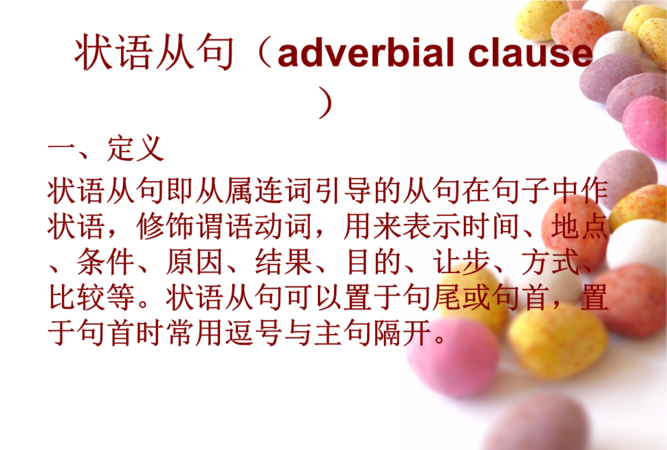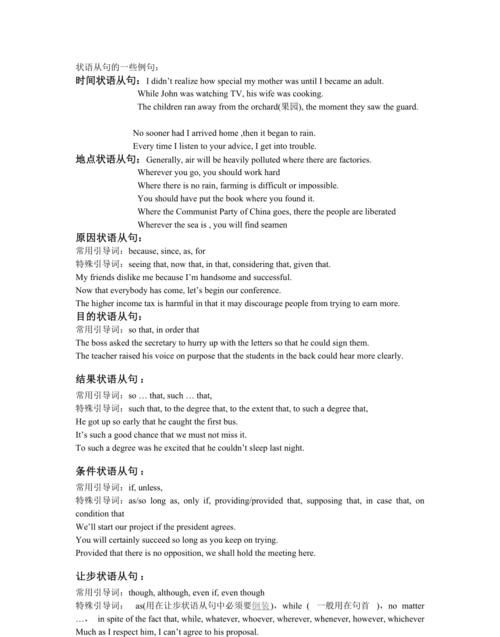本文目录
主谓宾加状语英语句子
如下:
1.He runs fast他跑得快
he是主语 runs是谓语动词 fast 副词做状语
2. He gets up early in the morning.他早上早起
he是主语 get up 动词短语作谓语 early in the morning作状语
3.She is crying sadly 她哭得很伤心
she是主语 is crying是谓语 sadly是状语

4.She sings well她唱得好
she是主语 sings是谓语 well是状语
5.She sits behind me.她坐我后面
she是主语 sits是谓语 behind me是状语
状语的构成
经常充当状语的有形容词,副词,时间处所名词,能愿动词,指示代词,以及方位短语、介词短语、动宾短语、谓词性联合短语、谓词性偏正短语、谓词性主谓短语等。
含有动量词的数量短语以及重叠式的数量短语(不论动量,物量)也可以充当状语。
此外,少数名词带上表比况的助词也可以作状语。
英语中的状语有哪些
一、主语:主语表示句子主要说明的人或事物,一般由名词,代词,数词,不定式等充当。
例句:He likes watching TV.他喜欢看电视。
二、谓语:谓语说明主语的动作,状态或特征。
一般可分为两类
1、简单谓语
由动词(或短语动词)构成;可以有不同的时态,语态和语气。
例句:We study for the people.我们为人民学习。
2、复合谓语,情态动词,不定式
例句:I can speak a little English.我可以说一点英语。
三、表语:表语是谓语的一部分,它位于系动词如be之后,说明主语身份,特征,属性或状态。一般由名词,代词,形容词,副词,不定式,介词短语等充当。
例句: My sister is a nurse.我姐姐是护士。
四、宾语:
1、宾语表示动作行为的对象,跟在及物动词之后,能作宾语的有名词,代词,数词,动词不定式等。
例句:We like English.我们喜欢英语。
2、有些及物动词可以带两个宾语,往往一个指人,一个指物,指人的叫间接宾语,指物的叫直接宾语。
例句: He gave me some ink.他给了我一点墨水。
3、有些及物动词的宾语后面还需要有一个补足语,意思才完整,宾语和它的补足语构成复合宾语。
例句:We make him our monitor.我们选他当班长。
五、宾补:就是宾语补足语,就是补充说明宾语的
例句:I know you are student good at maths 在这个句子中good at maths 就是补语。
1、宾语补语也可以是句子,所以这个句子也可以是 I know you are student who is good at maths
2、还可以是-ing 形式I see you crossing the street
简单说就是补充和说明主语和宾语的成分.因此,就出现了主语补足语和宾语补足
语.
六、定语:在句中修饰名词或代词的成分叫定语。
1、用作定语的主要是形容词,代词,数词,名词,副词,动词不定式,介词短语等。形容词,代词,数词,名词等作定语时,通常放在被修饰的词前面。
例句:He is a new student.他是个新生。
2、但副词,动词不定式,介词短语等作定语时,则放在被修饰的词之后。
例句:The bike in the room is mine.房间里的自行车是我的。
七、状语:修饰动词,形容词,副词以及全句的句子成分,叫做状语。用作状语的通常是副词,介词短语,不定式和从句等。状语一般放在被修饰的词之后或放在句尾。副词作状语时可放在被修饰的词前或句首。
例句:He lives in London.他住在伦敦。

英语中的状语从句有几类 请分别举例
1.时间状语从句 when ,while, as ,before, after, since, till/until, once, every/each time, whenever, [as soon as, the moment/the minute , hardly…when no sooner…than] 1)when , while , as ...

英语状语例句20个
1.时间状语从句
when ,while, as ,before, after, since, till/until, once, every/each time, whenever, [as soon as, the moment/the minute , hardly…when no sooner…than]
1)when , while , as
都可表当……时,但有区别。
while 引起从句,表一段时间,而不是一点。有时还有对比的含义。
While she was reading the newspaper, Grandma fell asleep.
While I was reading , she was playing.
When 可表从句动作先于或后于主句中的谓语动词而发生。
When you have finished your report, you should type it out.
另:when 可表“那时、突然”之意。
I was cooking in the kitchen, when I heard a terrible sound.
as 强调动作的同时性,一边,一边
As I was washing dishes, I sang songs.
as 还可表“随着时间推移”
You will get wiser as you grow wiser.
2) as soon as, the moment/the minute , hardly…when no sooner…than
都可指“一……就” ,hardly…when 和no sooner…than 使用时通常用过去完成时,且常用倒装。
He fell asleep the moment he went to bed.
Hardly had he gone to bed when he fell asleep.
注意:
在时间状语从句中,不能出现将来时的形式。
2.原因状语从句
as , since, because, now that 等引导。
because 表直接的原因或理由,常译为因为。
since 一般表对方已知的,无须加以说明的既成事实的理由,常译为“既然”。
as 和because 语意相近,但语气较后者弱。
另外还有一个起并列连词作用的for , 只能放于后半部,表示一种推理或解释,或用作附加说明。
The day must break , for the birds are singing.
3.地点状语从句
where, wherever ;注意不要和where所引起的定语从句弄混。
We shall go where working conditions are difficult.(地点状语从句)
We shall go to the place where working conditions are difficult.(定从,有先行词)
4.条件状语从句
if , unless, so(as ) long as, so far as , in case
注意从句中不能出现将来时的形式。
5.让步状语从句
although(though), even if (though), however, whatever
注意: though (although)引起从句时,主句中不能出现but 。
as 引起从句时,要采用倒装。
Clever as he is, he doesn't study well.
6.结果状语从句
so, so (…)that , such…that 引导,放在主句之后。
7.目的状语从句
so that , in order that 引导,放于主句之后。
注意:so (…)that 和 so that 的不同。
so that 引导目的状语从句时,从句中常会出现can , may, should 等情态动词,而so…that 则没有。
I'll show it to you again so that you can see it clearly.我再演示一次以便你能看清楚些。
He showed it me again so that I saw it clearly.他又演示一次,结果我看清了。
8.方式状语从句
as, as if , as though 等引导。
as if 或as though 引导的从句,既可用陈述语气,也可用虚拟语气,表与主观上的不符。
He looks as if he is ill. (说话方认为他有病。)
He looks as if he were (was) ill.(说话方并不相信他有病)
9.比较状语从句
as…as, than , not so …as…
注意:比较状语从句部分常用省略结构。
I know you better than he does.

以上就是关于英语中状语的例句 ,主谓宾加状语英语句子的全部内容,以及英语中状语的例句 的相关内容,希望能够帮到您。

